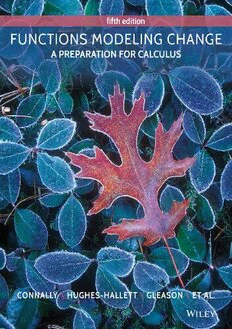
Functions Modeling Change A Preparation For Calculus, 5th Edition PDF
Preview Functions Modeling Change A Preparation For Calculus, 5th Edition
FUNCTIONS MODELING CHANGE: A Preparation for Calculus FifthEdition ProducedbytheCalculusConsortiumandinitiallyfundedbyaNationalScienceFoundationGrant. EricConnally DeborahHughes-Hallett HarvardUniversityExtension TheUniversityofArizona AndrewM.Gleason PhilipCheifetz HarvardUniversity NassauCommunityCollege AnnDavidian DanielE.Flath Gen.DouglasMacArthurHS MacalesterCollege SelinKalaycıoğlu BrigitteLahme NewYorkUniversity SonomaStateUniversity PattiFrazerLock GuadalupeI.Lozano St.LawrenceUniversity TheUniversityofArizona WilliamG.McCallum JerryMorris TheUniversityofArizona SonomaStateUniversity KarenRhea EllenSchmierer UniversityofMichigan NassauCommunityCollege PatShure AdamH.Spiegler UniversityofMichigan LoyolaUniversityChicago CarlSwenson AaronD.Wootton SeattleUniversity UniversityofPortland ElliotJ.Marks withtheassistanceof FrankAvenoso DouglasQuinney KatherineYoshiwara NassauCommunityCollege UniversityofKeele LosAngelesPierceCollege DedicatedtoBen,Jonah,andIsabel PUBLISHER LaurieRosatone ACQUISITIONSEDITOR JoannaDingle ASSOCIATEEDITOR JacquelineSinacori MARKETINGMANAGER KimberlyKanakes SENIORPRODUCTDESIGNER TomKulesa SENIORCONTENTMANAGER KarolineLuciano SENIORPRODUCTIONEDITOR KenSantor FREELANCEPROJECTEDITOR AnneScanlan-Rohrer EDITORIALPROGRAMASSISTANT CourtneyWelsh MARKETINGASSISTANT JesseAdler COVERDESIGNER MadelynLesure COVERANDCHAPTEROPENINGPHOTO ©PatrickZephyr/PatrickZephyrNaturePhotography ThisbookwassetinStixbytheConsortiumusingTeX,Mathematica,andthepackageAsTeX,whichwaswritten byAlexKasman.TheprocesswasmanagedbyElliotMarks. Copyright©2015,2012,2011,2006,2003JohnWiley&Sons,Inc.Allrightsreserved. Foundedin1807,JohnWiley&Sons,Inc.hasbeenavaluedsourceofknowledgeand understandingformorethan200years,helpingpeoplearoundtheworldmeettheir needsandfulfilltheiraspirations.Ourcompanyisbuiltonafoundationofprinciples thatincluderesponsibilitytothecommunitiesweserveandwhereweliveandwork. In2008,welaunchedaCorporateCitizenshipInitiative,aglobalefforttoaddressthe environmental,social,economic,andethicalchallengeswefaceinourbusiness.Among theissuesweareaddressingarecarbonimpact,paperspecificationsandprocurement, ethicalconductwithinourbusinessandamongourvendors,andcommunityandcharitable support.Formoreinformation,pleasevisitourwebsite:www.wiley.com/go/citizenship. Nopartofthispublicationmaybereproduced,storedinaretrievalsystemortransmitted inanyformorbyanymeans,electronic,mechanical,photocopying,recording,scanning orotherwise,exceptaspermittedunderSections107or108ofthe1976UnitedStates CopyrightAct,withouteitherthepriorwrittenpermissionofthePublisher,or authorizationthroughpaymentoftheappropriateper-copyfeetotheCopyright ClearanceCenter,222RosewoodDrive,Danvers,MA01923,(508)750-8400,fax (508)750-4470.RequeststothePublisherforpermissionshouldbeaddressedtothe PermissionsDepartment,JohnWiley&Sons,Inc.,111RiverStreet,Hoboken,NJ 07030,(201)748-6011,fax(201)748-6008,wbsite:http://www.wiley.com/go/permissions. ThismaterialisbaseduponworksupportedbytheNational ScienceFoundationunderGrantNo.DUE-9352905.Opinions expressedarethoseoftheauthorsandnotnecessarilythose oftheFoundation. ISBN-13978-1-118-58319-7(Paper) ISBN-13978-1-118-98630-1(Cloth) ISBN-13978-1-118-94258-1(BRV) PREFACE Inthe21st century,studentsneedtheabilitytosolveproblems;innovationdependsoncitizenswhocan thinkcritically.The fiftheditionof FunctionsModelingChange:A Preparationfor Calculusreaffirmsour efforttorefocustheteachingofmathematicsinabalancedblendofconceptsandprocedures.Ourapproach encouragesstudents to develop their problem-solvingskills while acquiring the mathematical background neededtolearncalculusorpursuetheircareers. FifthEdition:Focus ThiseditionofPrecalculuscontinuestostressconceptualunderstandingandtheconnectionsamongmathe- maticalideas.Understandingexponentialchange,forexample,meansbeingabletorelatethesizeofapercent growthtotheshapeofafunction’sgraph,aswellasassessingthereasonabilityofamodel. Functionsarethefoundationofmuchofmathematics.Ourapproachencouragesarobustunderstanding offunctionsintraditionalandnovelcontexts.Skillsareintroducedandreinforcedthroughoutthebook.This balanceofskillsandunderstandingpromotesstudents’criticalthinking. FifthEdition:Flexibility Precalculus courses are taken by a wide range of students and are taught in a wide variety of styles. As instructors ourselves, we know that the balance we choose dependson the students we have: sometimes a focusonconceptualunderstandingisbest;sometimesmoreskill-buildingisneeded. Toenableinstructorstoselectthebalanceappropriatefortheirstudents,thefiftheditionexpandstheop- tionsavailableforcustomizingmaterial.Forexample,wehaveintegratedexamplesinvolvinglinearinequal- itiesinourtreatmentoflinearequations,andofferedmoreexamplesonratesofchangeinseveralchapters. Thesectionsinvolvinglimitnotationandphaseshifthavebeenrestructuredsothatthesetopicscanbeeasily skipped.TransformationsoffunctionsarenowintroducedinChapter2,whilethefulltreatmentremainsin Chapter6,providinginstructorswithmorefreedomaboutwhentointroducethemandhowdeeplytocover thistopic. OriginofText:TheCalculusConsortiumforHigherEducation Thisbookistheworkoffacultyatadiverseconsortiumofinstitutions,andwasoriginallygenerouslysup- portedbytheNationalScienceFoundation.Itrepresentsthefirstconsensusamongsuchadiversegroupof facultytohaveshapedamainstreamprecalculustext.Bringingtogethertheresultsofresearchandexperience withtheviewsofmanyusers,thistextisdesignedtobeusedinawiderangeofinstitutions. GuidingPrinciples:VariedProblemsandtheRuleofFour Conceptualunderstandingisenhancedwhenstudentsengageinnon-proceduralproblem-solving.Problems classified into clear-cut types tend to develop proficiency at finding answers, but not necessarily a robust conceptualunderstanding.Strongproblem-solversfeel capable of makingprogresson problemsthey have notseenbefore,notjustthoseofknowntype.Consequently,weareguidedbythefollowingprinciples: • Problemsare variedand often challenging.Many of our problemscannotbe answeredby following a templateinthetext. • Textexamplesarediverseandrepresentthenaturalintegrationofskillsandconcepts. • TheRuleofFour:eachconceptandfunctionisrepresentedsymbolically,numerically,graphically,and verbally.Thisprinciple,originallyintroducedbytheConsortium,promotesmultiplerepresentations. v vi Preface • Weprovidestudentsandinstructorsquickmeansofassessingcomprehensionbeforemovingonbyusing thetrue-falseStrengthenYourUnderstandingproblemsattheendofeachchapter. • Ourcentraltheme,functionsasmodelsofchange,linksthecomponentsofourprecalculuscurriculum. Algebraisintegratedwhereappropriate. • Topicsarefewerinnumberthanitiscustomarysotheycanbetreatedingreaterdepth.Thetopicsare thoseessentialtothestudyofcalculus. • Problemsinvolvingrealdatagivestudentspracticewithmodeling. • We include both classic and current applications to prepare students to model with mathematics in a varietyofcontexts. • Ourproblemsallowstudentstobecomeproficientintheuseoftechnology,includingsymbolicmanipu- lators,computers,tablets,andonlinesoftware,asappropriate. • Ourprecalculusmaterialsallowforabroadrangeofteachingstyles.Theyareflexibleenoughforusein largelecturehalls,smallclasses,oringrouporlabsettings. ChangesintheFifthEdition The fifth edition reflects the many helpful suggestions from users while preserving the focus and guiding principlesofpreviouseditions.Wehavemadethefollowingchanges: • Many examples and problems are new or have been rewritten. Data has been updated and new data introduced. • Thethreechaptersontrigonometryhavebeenreorganizedandrewritten: − Trigonometric functions on the circle are introduced both in radians and degrees in Chapter 7, highlightingthenaturalrelationshipbetweenradiansandtheunitcircleassoonasperiodicfunctions areintroduced. − Sinusoidalfunctionsmodelingperiodicphenomenaandsimpletrigonometricequationsarealso introducedinChapter7,whilemoreinvolvedtrigonometricmodelsandequationsrequiringrelation- shipssuchasdouble-angleidentitiesaretreatedinChapter9. − PhaseshifthasbeenmadeanoptionaltopicinChapter7. − TriangletrigonometryisdiscussedseparatelyinChapter8,aftertrigonometricandsinusoidalfunc- tionsaretreatedinChapter7. • Abriefexplorationoflinearinequalitieshasbeenintegratedwiththematerialonsolvinglinearequations inChapter1. • VerticalandhorizontalshiftsareintroducedinChapter2,andreferencedinChapter3whenintroducing thevertexformofaquadraticequation.ShiftsarereviewedatthebeginningofChapter6andconsidered incombinationwithothertransformations. • Oddandevenfunctionsareintroducedbylookingatinvarianceofcertainfunctionsunderreflections, andthusbetterintegratedwiththetransformationfocusofChapter6. • Theeffectofchangingtheorderoftransformations,thelastsectioninChapter6inthefourthedition, hasbeenshortenedandincludedintheprevioussection. • The section on power functions in Chapter 11 has been rewritten to increase the focus on graphical behaviorandproportionality. • Examples on average rate of change have been added throughoutthe book, such as for exponential functions(inChapter5)andperiodicfunctions(inChapters7and9). • WileyPLUS,theprimaryonlineresourcesuitepairedwiththetextbook,hasbeenupdatedwithimproved problemsandhints,includingmanynewproblemsfromthefifthedition. Preface vii WhatStudentBackgroundisExpected? Studentsusingthisbookshouldhavesuccessfullycompletedacourseinintermediatealgebraorhighschool algebraII.Thebookisthought-provokingforwell-preparedstudentswhilestillaccessible tostudentswith weaker backgrounds.Providingnumerical, graphical,and algebraic approachesbuilds on different student strengthsandprovidesstudentswithavarietyofwaystomasterthematerial.Multiplerepresentationsgive studentstoolstopersist,loweringfailurerates. OurExperiences Thefirstfoureditionsofthisbookwereusedathundredsofschoolsaroundthecountryinawidevarietyof settings.Ithasbeenusedsuccessfullyinbothsemesterandquartersystems,inlargelecturesandsmallclasses aswellasinfull-yearcoursesinsecondaryschools.Ithasalsobeenusedincomputerlabsandsmallgroups, oftenwiththeintegrationofanumberofdifferenttechnologies. Content Thecentralthemeofthisbookisfunctionsasmodelsofchange.Weemphasizethatfunctionscanbegrouped intofamiliesandthatfunctionscanbeusedasmodels.We explorehowfunctioncharacteristicsconnectto differencequotientsandratesofchange,naturallypreviewingkeycalculusideas. Becauselinear,quadratic,exponential,power,andperiodicfunctionsaremostfrequentlyusedtomodel physicalphenomena,theyareintroducedbeforepolynomialandrationalfunctions.Onceintroduced,afamily offunctionsiscomparedandcontrastedwithotherfamiliesoffunctions. Alargenumberoftheexamplesthatstudentsseeinthisprecalculuscoursearereal-worldproblems.By theendofthecourse,wehopethatstudentswillusefunctionstohelpthemunderstandtheworldinwhich theylive.Weincludenon-routineproblemstoemphasizethatsuchproblemsarenotonlypartofmathematics, butinsomesensearethereasonfordoingmathematics. Technology Thebookdoesnotrequireanyspecificsoftwareortechnology.Instructorshaveusedthematerialwithgraph- ingcalculators,graphingsoftware,orscientificcalculators. Chapter1:LinearFunctionsandChange Thischapterintroducestheconceptofafunctionaswellasgraphical,tabular,symbolic,andverbalrepresen- tationsoffunctions,discussingtheadvantagesanddisadvantagesofeachrepresentation.Itintroducesratesof changeandusesthemtocharacterizelinearfunctions.Examplesonmodelingwithlinearfunctions,including interpretinglinearinequalities,arediscussed.Asectiononfittingalinearfunctiontodataisincluded. TheSkillsRefreshersectionforChapter1reviewslinearequations,linearinequalities,andthecoordi- nateplane. Chapter2:Functions Thischapterstudiesfunctionsin moredetail.Itintroducesdomain,range,previewsfunctionshiftsandthe conceptsofcompositeandinversefunctions,andinvestigatestheideaofconcavityusingratesofchange.A sectiononpiecewisefunctionsisincluded. Chapter3:QuadraticFunctions This chapter introducesthe standard,factored,and vertex formsof a quadraticfunctionand explorestheir relationshiptographs,includingshifts.Thefamilyofquadraticfunctionsprovidesanopportunitytoseethe effectofparametersonfunctionalbehavior. TheSkillsRefreshersectionforChapter3reviewsfactoring,completingthesquare,andquadraticequa- tions. viii Preface Chapter4:ExponentialFunctions Thischapterintroducesthefamilyofexponentialfunctionsandthenumber𝑒.Itcomparesexponentialand linearfunctions,solvesexponentialequationsgraphically,andgivesapplicationstocompoundinterest. TheSkillsRefreshersectionforChapter4reviewsthepropertiesofexponents. Chapter5:LogarithmicFunctions Thischapterintroduceslogarithmicfunctionswithbase10andbase𝑒,bothinordertosolveexponentialequa- tionsandasinversesofexponentialfunctions.Afterdiscussingmanipulationswithlogarithms,thechapter focusesonmodelingwithexponentialfunctionsandlogarithms.Logarithmicscalesandasectiononlineariz- ingdataconcludethechapter. TheSkillsRefreshersectionforChapter5reviewsthepropertiesoflogarithms. Chapter6:TransformationsofFunctionsandTheirGraphs Thischapterinvestigatestransformations.Itrevisitsshifts,introducesreflectionsandstretches,andexplores even and odd symmetry using transformations. The effect of orderingwhen combining transformationsis explored. Chapter7:TrigonometryandPeriodicFunctions Thischapterintroducestrigonometricfunctionsinbothradiansanddegreesasmodelsforperiodicmotion. Afterexploringgraphsandformulasofsine,cosine,andtangent,generalsinusoidalfunctionsareintroduced. Thischapterintroducestheinversetrigonometricfunctionstosolvetrigonometricequations. TheSkillsRefreshersectionforChapter7reviewssineandcosinevaluesofspecialanglesmeasuredin bothradiansanddegrees. Chapter8:TriangleTrigonometryandPolarCoordinates Thischapterdevelopsright-triangletrigonometry,andintroducestheLawofSinesandtheLawofCosines.It alsodefinespolarcoordinates,explorestheirrelationshiptoCartesiancoordinates,andconsidersthegraphs ofpolarinequalities. Note:Chapter8canbeskippedbyinstructorswhoprefernottoemphasizetriangletrigonometry. Chapter9:TrigonometricIdentities,ModelsandComplexNumbers Thischapteropenswithadiscussionoftrigonometricequations,andthenexplorestrigonometricidentities and their rolein trigonometricmodels,such as dampedoscillationsand acoustic beats. The chaptercloses withcomplexnumbers,includingEuler’sFormulaanddeMoivre’stheorem. Chapter10:Compositions,Inverses,andCombinationsofFunctions Thischapterdiscussescombinationsoffunctions.Itinvestigatescompositeandinversefunctions,whichwere introducedinChapter2,inmoredetail. Chapter11:PolynomialandRationalFunctions Thischapterdiscussespowerfunctions,polynomials,andrationalfunctions.Thechapterexploresdominance and long-run behavior and concludes by comparing polynomial and exponential functions, and by fitting functionstodata. TheSkillsRefreshersectionforChapter11reviewsalgebraicfractions. Chapter12:Vectors This chapter contains materialon vectors and operationsinvolving vectors. An introductionto matrices is includedinthelastsection. Preface ix Chapter13:SequencesandSeries Thischapterintroducesarithmeticandgeometricsequencesandseriesandtheirapplications. Chapter14:ParametricEquationsandConicSections The concluding chapter looks at parametric equations, implicit functions, hyperbolic functions, and conic sections:circles,ellipses,andhyperbolas.Thechapterincludesasectiononthegeometricalpropertiesofthe conicsectionsandtheirapplicationstoorbits. Note:Chapter14isavailableonlineonly. SupplementaryMaterials Thefollowingsupplementarymaterialsareavailableforthefifthedition: • The Instructor’s Manual contains teaching tips, lesson plans, syllabi, and worksheets. It has been expanded and revised to include worksheets, identification of technology-orientedproblems, and new syllabi.(ISBN978-1-119-01383-9) • ThePrintedTestBankcontainstestquestionsarrangedbysection. • TheInstructor’sSolutionManualhascompletesolutionstoallproblems.(ISBN978-1-118-94162-1) • The Student Solution Manual has complete solutionsto half of the odd-numberedproblems.(ISBN 978-1-118-94163-8) • TheComputerizedTestBank,availableinbothPCandMacintoshformats,allowsinstructorstocreate, customize, and print a test containing any combinations of questions from a large bank of questions. Instructorscanalsocustomizethequestionsorcreatetheirown. • Classroom Activities are posted at the book companion website. These activities were developed to facilitatein-classgroupworkaswellastointroducenewconceptsandtopracticeskills.Inadditionto theblankcopiesforeachactivitythatcanbehandedouttothestudents,acopyoftheactivitywithfully workedoutsolutionsisalsoavailable. • TheBookCompanionSiteatwww.wiley.com/college/connallycontainsallinstructorsupplements. • WileyPLUSisapowerfulonlinesuiteofteachingandlearningresourcestightlyintegratedwiththetext. WileyPLUSenablesinstructorstoassign,deliverandgradeindividuallycustomizedhomeworkassign- mentsusingexercisesandproblemsfromthetext.Studentsreceiveimmediatefeedbackontheirhome- workandaccesstofullsolutionstoassignedproblemselectronically.Studentsmayalsoaccesshintsto theproblems.Inadditiontoonlinehomework,WileyPLUSprovidesstudenttutorials,aninstructorgrade- book,integratedlinkstotheelectronicversionofthetext,andallofthetext’ssupplementalmaterials. Formoreinformation,visitwww.wiley.com/college/wileyplusorcontactyourlocalWileyrepresentative formoredetails. • Mini-lectureVideoslinkedwithexamplesintheWileyPLUSstudentversionofthetextprovidegreater detailtothesolutionofexamplesineachsectionofthetext.Thesemayassiststudentsinreadingthetext priortoclassorinreviewingmaterialafterclass. • The Faculty Network is a peer-to-peernetwork of academic faculty dedicated to the effective use of technologyintheclassroom.Thisgroupcanhelpyouapplyinnovativeclassroomtechniques,implement specificsoftwarepackages,andtailorthetechnologyexperiencetothespecificneedsofeachindividual class.Visitwww.wherefacultyconnect.comoraskyourWileyrepresentativefordetails. ConcepTests ConcepTests, modeledon the pioneeringwork of Harvardphysicist Eric Mazur,are questionsdesignedto promoteactivelearningduringclass,particularly(butnotexclusively)inlargelectures.Ourevaluationdata showstudentstaughtwithConcepTestsoutperformedstudentstaughtbytraditionallecturemethods73%ver- sus17%onconceptualquestions,and63%versus54%oncomputationalproblems.ConcepTestsarrangedby x Preface sectionareavailableinPowerPointandClassroomResponseSystem-readyformatsfromyourWileyrepre- sentative.(ISBN978-1-118-94161-4) Acknowledgments We would like to thank the many people who made this book possible. First, we would like to thank the NationalScienceFoundationfortheirtrustandtheirsupport;weareparticularlygratefultoJimLightbourne andSpudBradley. WearealsogratefultoourAdvisoryBoardfortheirguidance:BenitaAlbert,LidaBarrett,SimonBernau, RobertDavis,LoveniaDeconge-Watson,JohnDossey,RonaldDouglas,EliFromm,BillHaver,DonLewis, SeymourParter,JohnPrados,andStephenRodi. Working with Laurie Rosatone, Anne Scanlan-Rohrer, Ken Santor, Shannon Corliss, Joanna Dingle, KimberlyKanakes,JacquelineSinacori,CourtneyWalsh,andMadelynLesureatJohnWileyisapleasure. Weappreciatetheirpatienceandimagination. Manypeoplehavecontributedsignificantlytothistext.Theyinclude:LaurenAkers,FahdAlshammari, DavidArias,TimBean,CharlotteBonner,BillBossert,BrianBradie,NoahS.Brannen,MikeBrilleslyper, DonnaBrouillette,MatthewM.Campbell,JoCannon,RayCannon,KennyChing,AnnaChung,PierreCres- sant,MarciaCrump,LaurieDelitsky,BobDobrow,HelenM.Doerr,IanDowker,CarolynEdmond,Maryann Faller, Aidan Flanagan, Brendan Fry, Brad Garner, Carrie Garner, John Gerke, Christie Gilliland, Wynne Guy,DonnieHallstone,David Halstead,LarryHenly,DeanHickerson,Jo EllenHillyer,Bob Hoburg,Phil Hotchkiss, MikeHuffman,Mac Hyman,Rajini Jesudason,LorenJohnson,David Jones,Scott Kaplowitch, Nazanin Karimi, Thomas Kershaw, Mary Kilbride, Steve Kinholt, Kandace Kling, Angela Kubena, Rob LaQuaglia, Barbara Leasher, Kenneth Lemp, Richard Little, David Lovelock, Guadalupe Lozano Terán, Nicholas Lyktey,Chaimaa Makoudi,Len Malinowski, NancyMarcus, Kate McGivney,GowriMeda, Bob Megginson,DeborahMoore,EricMotylinski,BillMueller,MichaelNakamaye,KyleNiedzwiecki,Karina Nielsen, KathrynOswald, IgorPadure,BridgetNeale Paris, Janet Ray,Ritam Ray,Ken Richardson,Halip Saifi,SharonSanders,MarySchumacher,MikeSeery,MikeSherman,DonnaSherrill,MaxShuchman,Fred Shure,KanwalSingh,MyraSnell,ReginaSouza,NatashaSpeer,SonyaStanley,MichaelSteuer,JimStone, PeggyTibbs,JeffTaft,EliasToubassi,JerryUhl,PatWagener,BenjaminWest,DaleWinter,TimothyWise- carver,andXianbaoXu. Reportsfromthefollowingreviewersweremosthelpfulinshapingthesecond,third,fourth,andfifthedi- tions:VictorAkatsa,JeffreyAnderson,BethBorel,LindaBraddy,MichaelBrassington,IngridBrown-Scott, Linda Casper, Kim Chudnick, Ted Coe, Ray Collings, Joe Coyle, Pam Crawford, Marcia Crump, Monica Davis, Laurie Delitsky, Phyllis Desormeaux, Helen Doerr, Diane Downie, Peter Dragnev, Patricia Dueck, Julie Fisher, Jennifer Fowler, Alyne Fulte, David Gillette, Jack Green, Zdenka Guadarrama, Donnie Hall- stone,JeffHoherz,MajidHosseini,RickHough,AnnHumes,BryanIngham,MaryLouJumonville,Pallavi Ketkar,WilliamKiele,MileKrajcevski,JohnLaMaster,RichardLane,DebbieLee,PhyllisLeonard,Daphne MacLean, Diane Mathios, Krista Maxson, Michael McAfee, Vince McGarry, Maria Miles, Laura Moore- Mueller,EllenMusen,DaveNolan,LindaO’Brien,ChrisParks,ScottPerry,JeffreyS.Powell,AnnePraderas, MichaelPrice,MaryRack,GregoryRhoads,JoeRody,EmilyRoth,JohnSawka,AmyN.Schachle,Barbara ShabellDeirdreSmith,ErnieSolheid,ReginaP.Souza,SandySpears,DianaStaats,JonathanStadler,Mary JaneSterling,DennisStramiello,DebbieStrance,AllisonSutton,JohnThomason,DianeVanNostrand,Jim Vicich,LindaWagner,NicoleWilliams,JimWinston,VauhnWittman-Grahler,BruceYoshiwara,FangZhao, andXinyunZhu.SpecialthanksareowedtoFayeRiddleforadministeringtheprojectandtoAlexKasman forhissoftwaresupport. EricConnally DeborahHughes-Hallett AndrewM.Gleason PhilipCheifetz AnnDavidian DanFlath SelinKalaycıoğlu BrigitteLahme PattiFrazerLock GuadalupeI.Lozano ElliotJ.Marks WilliamG.McCallum JerryMorris KarenRhea EllenSchmierer PatShure AdamH.Spiegler CarlSwenson AaronD.Wootton
